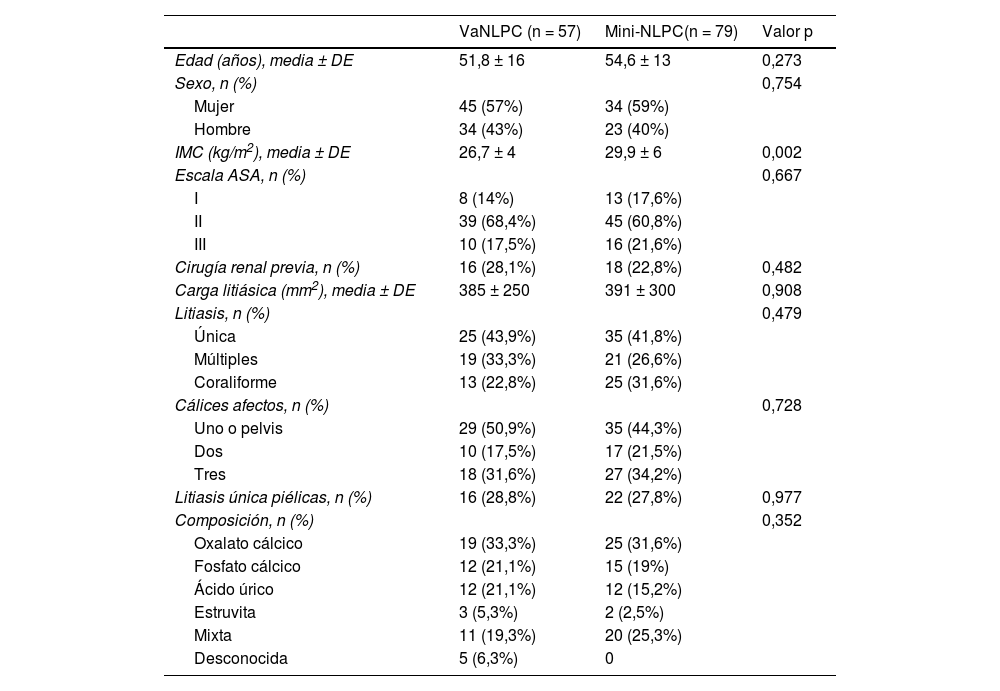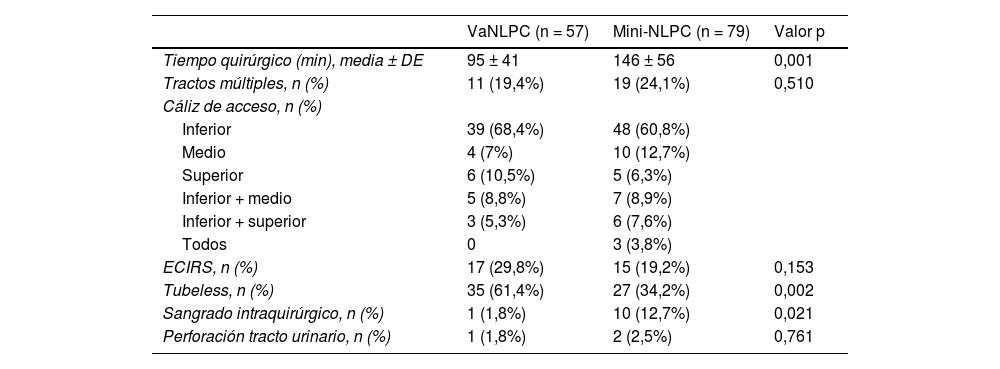La vaina de acceso asistida por vacío es un nuevo dispositivo para el tratamiento de los cálculos renales mediante nefrolitotomía percutánea (NLPC).
ObjetivoNuestro objetivo fue comparar la tasa libre de litiasis (TLL) y las complicaciones entre la mini-NLPC estándar y la asistida por vacío (VaNLPC).
MétodoEstudio retrospectivo de pacientes intervenidos mediante mini-NLPC y VaNLPC desde enero de 2018 hasta junio de 2022. La VaNLPC se realizó con una vaina desechable (ClearPetra®) que permite la conexión de aspiración por un canal lateral facilitando la extracción de fragmentos. Se recogieron las características basales de los pacientes, los resultados quirúrgicos y los datos perioperatorios y postoperatorios. Se compararon en cuanto a las complicaciones y la TLL.
ResultadosIdentificamos 136 pacientes, 57 (41,9%) intervenidos con VaNLPC y 79 (58,15%) con mini-NLPC. El tiempo quirúrgico medio fue significativamente menor en el grupo VaNLPC (95 min) que en el mini-NLPC (146 min; p = 0,001). La técnica tubeless se realizó con mayor frecuencia en el grupo VaNLPC (61,4 vs. 34,2%; p = 0,002). No se observaron diferencias en las complicaciones postoperatorias. El tiempo medio de hospitalización fue significativamente inferior en el grupo VaNLPC con 1,7 días por paciente frente a 2,7 días en el grupo mini-NLPC (p = 0,001). No hubo diferencias en la TLL a los tres meses entre VaNLPC (71,9%) y mini-NLPC (71,8%; p = 0,848).
ConclusionesLos pacientes tratados con VaNLPC obtuvieron resultados comparables a la mini-NLPC, mostrando una TLL igual con similares complicaciones infecciosas. Como potenciales beneficios de la VaNLPC, se postulan menor tiempo quirúrgico y estancia postoperatoria.
The vacuum-assisted access sheath is a new device for the treatment of kidney stones with percutaneous nephrolithotomy (PCNL).
ObjectiveOur aim was to compare the stone-free rate (SFR) and complications between standard mini percutaneous nephrolithotomy (mini-PCNL) and vacuum-assisted PCNL (Va-PCNL).
MethodsRetrospective study of patients undergoing mini-PCNL and Va-PCNL from January 2018 to June 2022. Va-PCNL was performed with a disposable sheath (ClearPetra) with continuous high-flow irrigation and vacuum fluid dynamics for easier stone fragment removal. Baseline patient characteristics, surgical outcomes, perioperative and postoperative data were collected. We compared SFR and complications.
ResultsA total of 136 patients were identified, 57 (41,9%) underwent Va-PCNL and 79 (58,15%) mini-PCNL. Mean operative time was significantly shorter in the Va-PCNL group (95 min.) than in mini-PCNL (146 min.; P = .001) group. The tubeless technique was performed more frequently in Va-PCNL group (61,4% vs. 34,2%; P = .002). We did not observe any differences in postoperative complications. The mean hospital stay was significantly lower in Va-PCNL with 1,7 ± 1,9 days per patient compared with 2,7 ± 1,5 days in the mini-PCNL group (P = .001). There were no differences in SFR at 3 months between Va-PCNL (71,9%) and mini-PCNL (71,8%; P = .848).
ConclusionPatients treated with Va-PCNL had comparable results to mini-PCNL, showing equal SFR with similar infectious complications rates. Potential benefits of Va-PCNL include shorter operative time and postoperative stay.












